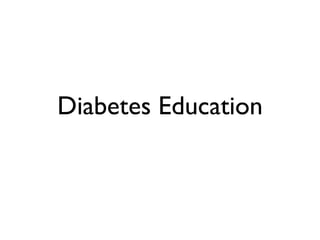Diabetes education presentation
- 2. Overview Diabetes - What is it? Complications/Risks Prevention - A New Lifestyle Signs and Symptoms of Adverse Events
- 3. Diabetes Insulin Important hormone that brings blood sugar (glucose), into your body’s cells. Essentially your energy transport!
- 4. Diabetes - Overview Glucose One of the main sources of energy for your body Brain uses Glucose ONLY - uses about 20% of the body’s need for glucose
- 5. Diabetes Types Type 1 Body does not produce INSULIN naturally “Insulin DEPENDENT” Type 2 Body is resistance to INSULIN “Insulin RESISTANT”
- 6. Diabetes Treatment Type 1 - INSULIN replacement therapy Type 2 - LIFESTYLE modification
- 7. Diabetes Complications Main culprit - DECREASED BLOOD FLOW HIGH blood sugar concentrations affect the inside layer of your blood vessels
- 8. Diabetic Complications Microangiopathy = damage to small blood vessels Mainly affects: eyes, kidneys, nerve endings
- 9. Diabetic Complications Macroangiopathy = damage to larger blood vessels Atherosclerosis = clogging of the blood vessels
- 10. Diabetic Complications Foot Uclers Combination of nerve damage and damaged blood supply Thus, POOR HEALING!
- 11. Any questions so far?
- 12. Get active with your care!
- 13. Getting Active Proper Nutrition Regular Physical Activity Foot Inspection
- 14. Proper Nutrition Goals: Reach healthy weight and control blood sugar Eat at about the same times each day Be consistent with the types of food you eat Careful meal planning
- 16. Regular Physical Activity Exercise has “INSULIN-LIKE” effects on blood sugar, thus can decrease blood sugar level Physical activity helps build better fitness and lose weight Minimum 30 minutes a day - best to do aerobic and strength training.
- 17. Foot Care About 7,200 nerve endings at your foot Nerve endings likely to suffer diabetic neuropathy Inspect feet twice a day and always after any physical activity
- 18. Foot Care Gentle cleaning Apply moisturizers (Dry skin likely to crack!) AVOID THE FOLLOWING: hot soaks, heating pads, and harsh topical agents like hydrogen peroxide, iodine (Betadine) and astringents
- 19. Foot Care More tips: Trim toe nails, keeping them neat and short Wear clean socks and comfortable shoes Use a mirror aid to inspect
- 20. Any questions so far?
- 21. Abnormal Blood Sugar Levels Hyperglycemia HIGH blood sugar levels Hypoglycemia LOW blood sugar levels Ask your MD/nurse what’s abnormal for you.
- 22. Abnormal Blood Sugar Levels Hyperglycemia Persisting Hyperglycemia Diabetic Ketoacidosis
- 23. Hyperglycemia Signs & Symptoms Signs & Symptoms High blood sugar level Frequent urination Increased thirst Dry mouth Blurry vision Fatigue or drowsiness
- 24. Persisting Hyperglycemic Signs & Symptoms Signs & Symptoms Difficulty breathing Dizziness when up to standing Rapid weight loss Increased drowsiness and confusion Unconsciousness or coma
- 25. Diabetic Ketoacidosis Body uses protein and fats for energy Life-threatening Symptoms: shortness of breath, nausea and vomiting, dry mouth, breath smells fruity, stomach pain
- 26. Hypoglycemic Symptoms Shakiness Dizziness Sweating Hunger Headache Pale skin color Sudden moodiness or behavior changes Clumsy or jerky movements Seizure Difficulty paying attention or confusion Tingling sensations around the mouth
- 27. Default Settings
- 28. Change the Defaults of your Life of your Life Creating a new default, eliminates the necessity to choose - the choice is already made! Establish new defaults: Regularly checking blood sugar Regularly inspecting your foot Exercise at your most convenient time
- 29. Summary Diabetes ultimately affect your blood vessels, which lead to more complications! Be active with your care with proper nutrition, physical activity, and regular foot inspections. Be aware of hypoglycemic and hyperglycemic symptoms. Create new lifestyle defaults for your diabetic condition.
- 30. Any Questions?






























